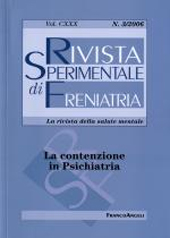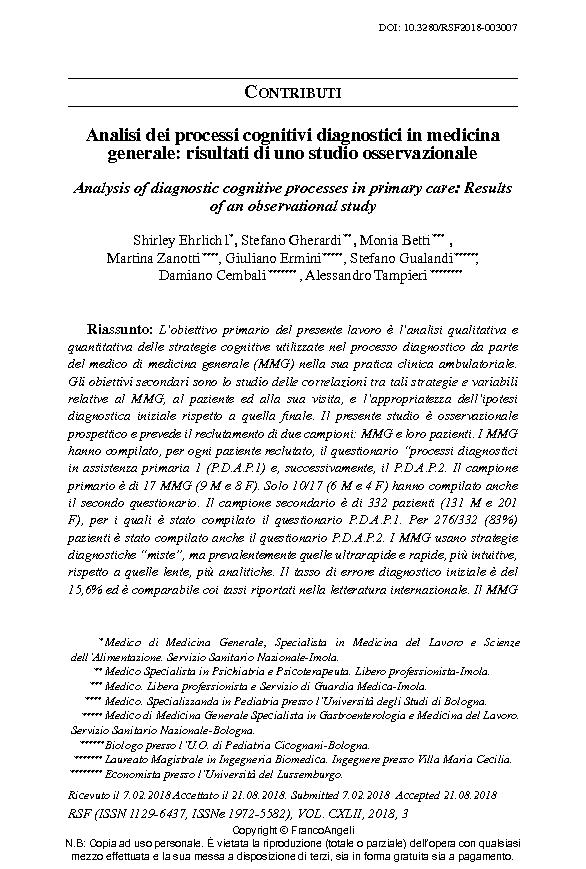Analisi dei processi cognitivi diagnostici in medicina generale : risultati di uno studio osservazionale
117-147 p.
L'obiettivo primario del presente lavoro è l'analisi qualitativa e quantitativa delle strategie cognitive utilizzate nel processo diagnostico da parte del medico di medicina generale (MMG) nella sua pratica clinica ambulatoriale. Gli obiettivi secondari sono lo studio delle correlazioni tra tali strategie e variabili relative al MMG, al paziente ed alla sua visita, e l'appropriatezza dell'ipotesi diagnostica iniziale rispetto a quella finale. Il presente studio è osservazionale prospettico e prevede il reclutamento di due campioni: MMG e loro pazienti. I MMG hanno compilato, per ogni paziente reclutato, il questionario "processi diagnostici in assistenza primaria 1" (P.D.A.P.1) e, successivamente, il P.D.A.P.2. Il campione primario è di 17 MMG (9 M e 8 F). Solo 10/17 (6 M e 4 F) hanno compilato anche il secondo questionario. Il campione secondario è di 332 pazienti (131 M e 201 F), per i quali è stato compilato il questionario P.D.A.P.1.
Per 276/332 (83%) pazienti è stato compilato anche il questionario P.D.A.P.2. I MMG usano strategie diagnostiche "miste", ma prevalentemente quelle ultrarapide e rapide, più intuitive, rispetto a quelle lente, più analitiche. Il tasso di errore diagnostico iniziale è del 15,6% ed è comparabile coi tassi riportati nella letteratura internazionale. Il MMG fa meno errori diagnostici quando usa prevalentemente metodi rapidi rispetto a quelli ultrarapidi e lenti (p<0,05). Riteniamo importante l'obiettivo di abbassare tale tasso, per aumentare il "safety netting" del paziente. A tal fine esistono già strumenti di comprovata efficacia, come le tecniche di debiasing, per contrastare i bias diagnostici cognitivi ed affettivi. [Testo dell'editore].
The authors presents a qualitative and quantitative analysis of the cognitive strategies - used by general practitioners (GPs) diagnosing outpatients - and studies the correlations between the GPs' cognitive strategies and other related variables, such as the patient and the patient visit, and the appropriateness between the initial diagnostic hypothesis and the final diagnosis. This study is prospective and observational and involved the recruitment of two samples: the GPs and their patients. For each recruited patient, the GPs filled out two questionnaires: the "Diagnostic Processes in Primary Care 1" (D.P.P.C.1) and the "Diagnostic Processes in Primary Care 2"(D.P.P.C.2). The sample of GPs comprises 17 GPs (9 M and 8 F). Only 10 GPs out of 17 (6 M and 4 F) filled out both questionnaires. The sample of patients comprises 332 patients (131 M and 201 F). 332 D.P.P.C.1 were filled out and 276 D.P.P.C.2 (83%).
The GPs used "mixed" diagnostic strategies, generally ultra-rapid or rapid, intuitive strategies, and used less the slow or more analytic strategies. The initial diagnostic error rate is 15,6%, comparable to the rates reported in the international literature. GPs do less diagnostic errors using rapid methods, than ultra-rapid or slow methods (p<0,05). The authors consider critical the target of decreasing this rate, in order to increase the patient's "safety netting". Furthermore, tools exist of proven effectiveness, e.g. debiasing techniques that counter diagnostic cognitive and affective biases. [Publishers' text].
Ist Teil von
Rivista sperimentale di freniatria : la rivista dei servizi di salute mentale : CXLII, 3, 2018-
Artikel aus derselben Ausgabe (einzeln erhältlich)
-
Informationen
ISSN: 1972-5582
THEMENBEREICHE
KEYWORDS
- Strategie cognitive diagnostiche, intuizione, bias, errore diagnostico, debias, Medicina Generale
- Diagnostic cognitive strategies, intuition, bias, diagnostic error, debias, primary care



